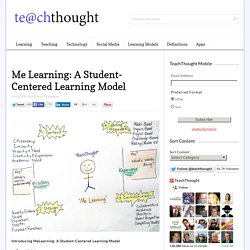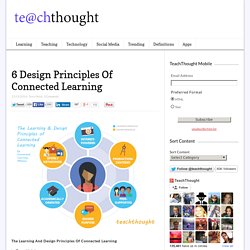

Self-regulated Learning. What is Self Regulated Learning? (Drs. Deborah Butler & Nancy Perry - Part 1. How can we foster Self Regulated Learning? (Drs. Deborah Butler & Nancy Perry - Part 3) How Do We Define and Measure “Deeper Learning”? Big Ideas Culture Teaching Strategies Flickr:Saxtourigr In preparing students for the world outside school, what skills are important to learn?

This goes to the heart of the research addressed in the Deeper Learning Report released by the National Research Council of the National Academies of Science in Washington. Simply defined, “deeper learning” is the “process of learning for transfer,” meaning it allows a student to take what’s learned in one situation and apply it to another, explained James Pellegrino, one of the authors of the report.
“You can use knowledge in ways that make it useful in new situations,” he said in a recent webinar. To deconstruct the definition of deeper learning further, the researchers came up with what they call three domains of competence: cognitive, intrapersonal and interpersonal. “The kinds of tasks we need to assess take kids more time to enact and more time to score.” Self-Directed Learning Techniques, Independant Learning Skills, Learning Methods.
SDL_SSDL. A Simple, Open-Ended Assignment: Explain When You're Creative. A Simple, Open-Ended Assignment: Explain When You’re Creative by Danielle Shanley, Director of Curriculum & Instruction for the New Milford Public Schools Below is an assignment recently given to a 10th grade classroom.

The assignment was inspired by Ken Robinson’s The Element. As you may remember, Ken Robinson defines The Element in the first book you read earlier this year with the same name. Within that text he explains that we all have talents and gifts. He firmly believes that we are all capable of being creative, and he reaffirms that within this book. Robinson suggests we need to know our own minds, realize our own potential talents, and allow ourselves to be stimulated by the work ideas and achievements of others. Assignment Part 1 Watch this video with Sir Ken Robinson prior to completing Part 2.
Assignment Part 2 You will share your “creative” experiences with the group. Tell the group about your creative self. Introducing Me Learning: A Student-Centered Learning Model. Introducing MeLearning: A Student-Centered Learning Model by Terry Heick A couple of years ago, I developed a kind of self-directed learning model.

At the time, I thought of it as a way to support students in understanding how to learn. It was designed to let students identify–on their own–what to learn as the critical core for understanding how to learn, while also requiring them to design when and with and through what means–learning strategies, technology, alone or together, project-based learning vs academic study, etc. Teaching students to think and learn isn’t simple–nor is it a matter of process. Beginning with a single student and extending outwards as a matter of interdependence, legacy, and ultimately citizenship is an ambitious and “costly” undertaking.
But that they don’t is also a symptom of the problem. Without that as a context, the “learning” is merely academic training. The Industry Of Learning The Goal The System & The Parts Content 1. 2. 3. 4. 6 Design Principles Of Connected Learning. The Learning And Design Principles Of Connected Learning by Terry Heick In 2015, no one should be hurting for compelling ed content.

Sites like edutopia, The Tempered Radical, Langwitches, Justin Tarte, Cool Cat Teacher, Grant Wiggins’ blog, and dozens of others offer outstanding reading on a daily basis to help you improve the things that happen in your classroom. (And this list is frustratingly incomplete–they’re just the sites on my radar that I’ve been reading since I entered education.)
A bit more “fringe” are sites like TeachThought, Jackie Gerstein’s UserGeneratedEducation, the Connected Learning Alliance and DMLCentral.net, MindShift, and so many more–“fringe” due to their thinking that seems as interested in understanding what’s possible in a modern learning environment as they are what is. You could even call this kind of content less immediately practical when you’re just Googling for a lesson idea for tomorrow, but there’s room for everyone in a digital and infinite world. The Genius Hour Design Cycle: A Process For Planning - 3.

Some students need a push in the right direction Some students will come up with projects that are too simple with answers that could be easily Googled. We introduced the students to ‘High Order Thinking Skills’ and built these into the planning forms students complete. Projects need to include elements of synthesis, evaluation and creativity with the minimum requirement adjusted for individuals. We provide students with a list of verbs appropriate for the top levels of Bloom’s taxonomy and help them use these in framing their topics. 4. A student might have a passion for surfing and decide they are going to write a book about the history of the sport. 5. It can be hard to say no to a project but some are just not feasible. 6. Some projects will clearly take longer than you have available, others are simply too large in scale or will rely on the involvement of too many people. 7. One of the challenges for some students has been the ever changing project.
SDL_SSDL.